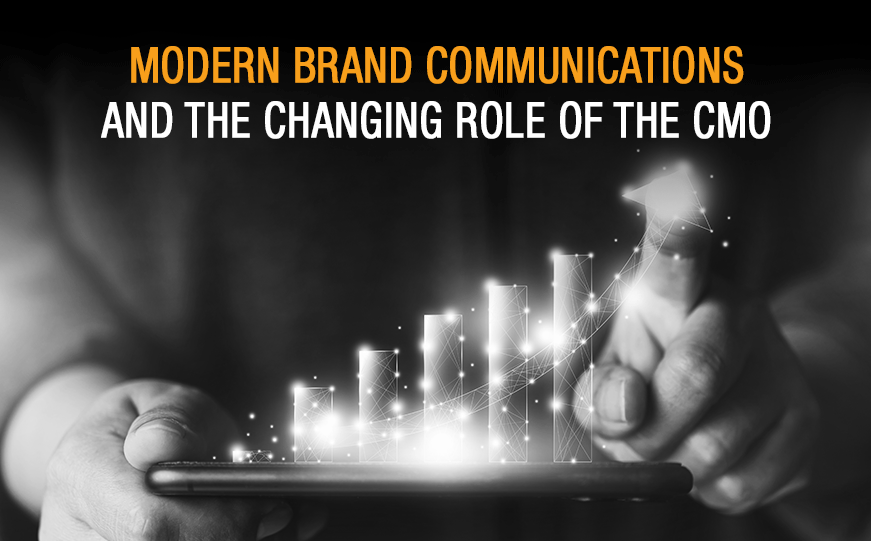The world is constantly evolving. And the pace of that change continues to accelerate.
Communications technology is advancing rapidly. At the same time, audience perception and expectations are shifting tectonically.
Through it all, the role of the Chief Marketing Officer — and everyone else tasked with brand communications — has had to adapt to fit the changing needs of modern organizations.
In fact, according to a report from Accenture, 88 percent of organizations agree that the role of the CMO has fundamentally changed.
CMOs and their support staff are no longer relegated to the focus of overseeing branding and marketing activities. Now, they are expected to take on more responsibilities for business growth and customer experience too.
To effectively meet the challenges of today’s business environment, corporate communications must transition from a cost center… to a generator of measurable value.
By prioritizing the delivery of an integrated customer experience — CMOs for building product brands have gained the opportunity to directly shape their organization’s growth — in highly impactful ways.
Communications in the Spotlight
While the pandemic that launched this decade has moderated in severity, its effect as a catalyst and driver for innovation will undoubtedly be recognized for many years to come:
- Communications have become even more vital to every leader — from CEOs to board directors to others in the C-suite, including CFOs.
- 87% of organizations agree that traditional ways of doing business are no longer enough to satisfy customers. Instead, company culture must be built around creating customer experiences… that are authentic and memorable.
- Modern brand communications have to be agile and insight-driven. Data matters. And communicators must be able to quickly pivot… when marketing efforts aren’t delivering expected results.
- Expectations around social issues have shifted the corporate agenda, and stakeholders are holding companies accountable. What a brand says and does matters.
- In an increasingly complex world, a consistent, relatable — and customer-centric — brand promises mean more than ever before.
A New Roadmap
Seemingly a lifetime ago, marketing revolved around the Four Ps: Product, Price, Place and Promotion.
The always “on” internet changed that focus to a playbook based on planning, marketing, reporting and assessing. Yet, even that framework has become challenged.
For brands to get the most out of their marketing effort… campaigns can’t remain static.
Publishing content. Measuring the results. And trying to improve it “the next time around” are now a relic of the past.
Instead, technology is making it possible to analyze campaign performance and then make refinements in real time… based on continuous feedback, results and trending analytics.
Marketing has increasingly become metric-driven. Which enables marketers to “optimize as they go.”
Automation technologies have made it easier to deliver this continuous improvement. And Artificial Intelligence (AI) allows marketers to deliver elevated customer experiences — including enhanced personalization and real-time interactions with audiences.
Creating Meaningful Connections
We have all grown more accustomed to remote communications and online sales models.
Thanks to increased digital fluency and experience managing online channels, brand marketers are accessing new tools and data-driven models to go beyond simply creating leads… to actively driving sales and revenue.
That said, it’s critically important to balance technology with personal connections. The goal should always be, “people led, tech-empowered.”
Customers and prospects are seeking credible stories about real-world experiences. And they’re looking for results that are relatable.
Of course, storytelling is not new.
But it’s growing in importance — as consumers demand more authenticity — from brands.
Brands must clearly define their stories… and then weave them into every piece of content produced. While presenting those promises consistently, across every channel.
A Path Forward – Resilience Rules the Day
Interrupted supply chains have drastically changed buying patterns. And progressive marketers have invested the last two years adapting to a new reality… where past processes and archaic ways of thinking simply can’t work anymore.
Despite these changes, business growth remains constant as every marketer’s chief goal.
Yes, with disruption comes opportunity. CMOs must focus on aligning data-driven marketing and sales operations that are flexible enough to respond to insights in real time. While focusing on creating exceptional customer experiences.
Brand leaders who actively respond to this paradigm shift can help to propel their offerings fast-forward, through differentiation and innovation.
Interested in exploring authentic — and memorable — ways to build your brand? Send an e-mail to sk@kleberandassociates.com to get the conversation started.




